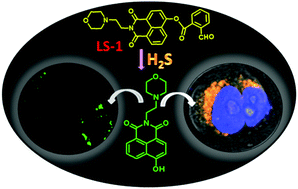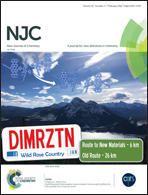A hydrogen sulfide triggered self-immolative fluorescent probe for lysosome labeling in live cells†
Abstract
We developed a naphthalimide-based, lysosome-targeting, and self-immolative fluorescent probe for H2S detection. Probe LS-1 comprises a 2-formylbenzoate derivative of the 1,8-naphthalimide fluorophore. H2S forms a thiohemiacetal intermediate by reacting with the formyl group of the 2-formylbenzoate derivative, which subsequently undergoes intramolecular cyclization with the ester moiety to generate a free naphthalimide fluorophore (FL-1). The UV-vis absorbance (λabs) value of probe LS-1 at 450 nm increased in the presence of H2S. Similarly, with increasing H2S concentrations, the emission band (λem) centered at 560 nm increased gradually. The probe was found to be highly sensitive and chemoselective towards H2S compared with other biological analytes. Probe LS-1 was nontoxic and very stable across the physiological pH range. The probe LS-1 enables the detection of intracellular endogenous H2S formation in HT29 cells in lysosomes.



 Please wait while we load your content...
Please wait while we load your content...